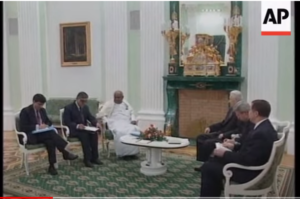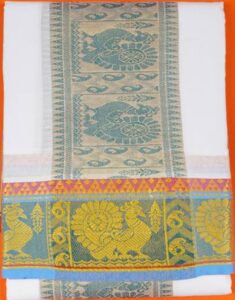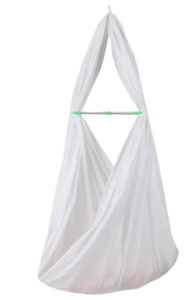Veshti (வேஷ்டி) is a humble piece of cloth that was worn by kings and commoners for centuries in Tamilnadu. Now only a small group of boomers and some politicians from Southern India are keeping the flag flying high ( or is it flying low ?)

Prime Minister Deve Gowda at Moscow 1997 at a wreath laying ceremony . It was a cold windy day ; a solemn occasion and the only sounds heard were the sounds of fluttering of the flags and the Indian PM’s Veshti. (Quoting from a newspaper report 🙂 ) Photo : Courtesy AP.

Here we go
Firstly it is not veshti but vetti as it is called in Tamil. The cloth was woven as long pieces and then cut into pieces as required by people as per their needs . Vetti in Tamil means ‘ to cut’.
The Sanskrit lovers made it Veshti to make it sound sanskritised!
It is a simple white piece of cloth in cotton or silk worn by men , and in earlier times this was the only attire for men of all ages , all classes.
Though it’s worn as a wrap-around skirt style to cover the lower part of the body, it is actually a multipurpose cloth.
It can be a headgear or a waist band ; can be worn like a poncho to protect from cold or mosquitoes (Southern India enjoys a hot winter and a hotter summer)
It is folded half mast to be worn like a pair of shorts; oh, not a pair really. With a little ingenuity, it is tied dhoti style to be a pair of trousers, shorts or something in between.
There are no buttons , pins, velcros or even knots to hold the garment in place ; so how does it stay there ?
Easy does it. While wrapping it around just suck in your waist and gently roll down the edge. There you are , it’s your breath that holds it in place to cover your modesty ! Hold your breath for a second and the breath holds the veshti for the whole day! Sounds nice !
A simple search on you tube would throw up visuals of the breath control involved in getting the garment in place .
Whatever, accidents or wardrobe malfunctions as they are called today do happen and a hand is always poised to stop the costume from slipping away. These days you have nice velcro belts with big brand names , available, but a puritan wouldn’t use these kind of crutches .
Wouldn’t it be boring to wear just white all day , all year around and where is creativity ?

Not really, veshtis have borders narrow or broad; that’s where creativity shows. You may have intricately made motifs on the borders. In ancient days these were made in gold and now it’s all plastic ,but the skill shows.
The border design is also used to make a political statement. The Dravidian parties have made it a feature to wear their ideology on the veshti borders , not just on their sleeves as an angrez would say. So when a Tamil politician jumps party, he has to change his whole ward robe !
Then you have the color veshtis where each colour indicates the religious inclination; black for Ayyappa, Red for Parashakti etc.
What is really interesting is the Avtar s that a veshti takes after the original purpose is accomplished. It is white, it is pure cotton and it’s fine. It is ideal for any kind of reuse from bedspread to bandages. The famous puthur traditional bone-setters use yards and yards of this kind of cloth .
Even about 50 years back a Tamil Brahmin housewife would have struggled without these worn out Veshtis. The cloth was white, fine and unstitched. It was used for all purposes like Idli cloth (anything steamed), drying papads in the sun, making jaangri ( imarti or the South Indian cousin of Jelebi).

Outside the kitchen , generally it was used as hammock for the baby. (thooli as it is called in Tamil )
In short there was more demand for old veshti than for the new ones. There are husbands who keep searching for their veshti all over the place only to find that, it has become a bedspread or hammock for the baby , too prematurely. God forbid, if the border had rich zari, a clever housewife would exchange it for some utensils at the first opportunity. There was a thriving industry for extraction of gold from veshti zari.
The only item of clothing that a man had to buy was veshti. This could also be gifted during functions as everyone used it and it was not only free-size but multipurpose.
Wish we go back to those times when life was simple.
The ancient Tamil poetess Avvaiyaar said ” உண்பது ஒரு நாழி, உடுப்பது நான்கு முழம் “; Meaning one can eat only about a cup of grains for food and four feet of fabric for covering ; but thoughts (desires) are in thousands bringing misery to man.
Man, that’s simplicity!
Are the activists keen to save this Earth listening?
On the lighter side, I can hear the advaitin expounding ” it’s all one , some call it veshti, some call it head gear or a waist band, some may call it idli cloth or hammock ; it’s all the same. The divine weaver weaves his magic cloth ; it’s all Maya !”
Tathastu
”

Great piece on Veshti Murali!
Thanks for the educative post Murali! Somehow I used to think that Veshti was a kind of shawl or stole made of cotton /silk.